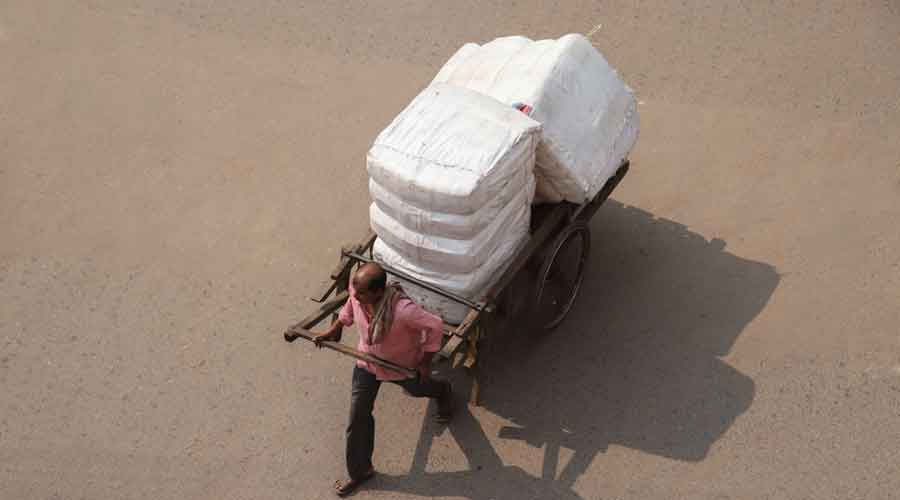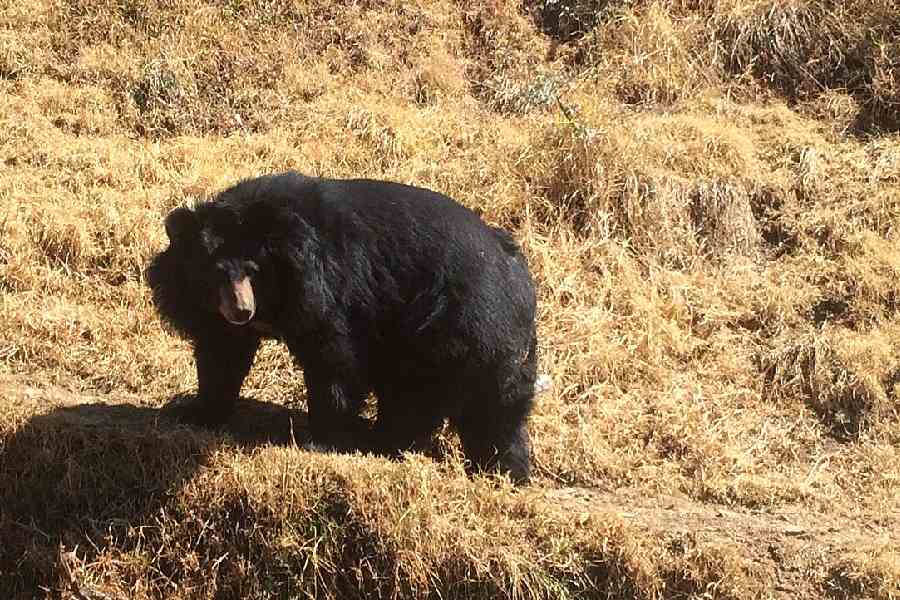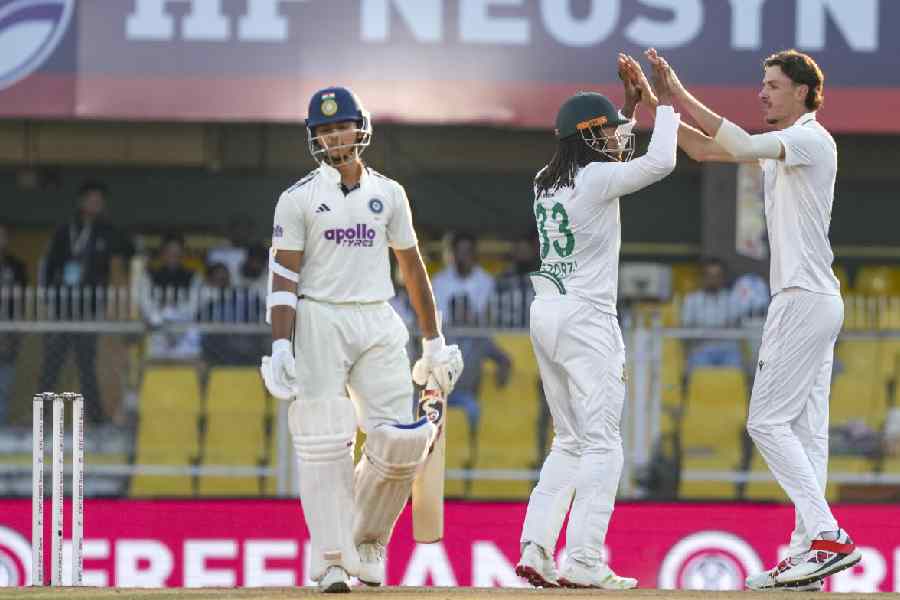Sridam Burman had just finished his lunch at a roadside eatery on NH27 and was waiting to board the bus that he and 60 other day labourers had hired from Dalkhola to return to their village in Sitalkuchi, Cooch Behar.
“We all work in a brick kiln in Dalkhola. We are returning home to vote,” said Sridam, a stocky, middle-aged man from the Rajbanshi community.
Around 2.3 lakh people in Sitalkuchi, set along the Bangladesh border, will vote on Saturday when 44 constituencies — 14 of them in north Bengal — go to the polls in the fourth of Bengal’s eight electoral phases.
North Bengal, home to 54 constituencies that will vote from the fourth to the eighth phase, is witnessing a high-pitched battle with Trinamul desperate to regain ground lost to the BJP over the past couple of years.
Sridam wouldn’t reveal his choice. “Let me return to the village and speak to others in my family and community. I will then decide who to vote for,” he said.
The Scheduled Caste Rajbanshis — known as bhumiputras (sons of the soil) and spread across Cooch Behar, Jalpaiguri, Alipurduar, Darjeeling and North and South Dinajpur — make up about a fourth of north Bengal’s 2.5 crore people. The community holds the key to at least 25 of the region’s 54 constituencies and is being wooed by all the major parties, especially Trinamul and the BJP. The campaigners have been focusing on the Rajbanshi identity.
This election has also witnessed all-out attempts by the political parties to reach out to the two other major groups in the region, the Gorkhas and the tribal communities. The 15 lakh-odd Gorkhas are significant to a dozen-odd constituencies in the hills and the plains while the tribals, making up around 11 per cent of the population, can influence the outcomes in 16 to 18 seats.
All these three statistically significant communities have brought identity politics to the heart of this election in north Bengal.
“Identity politics always had a role in north Bengal. It was important even during Left rule but the Left had ruthlessly suppressed it. Mamata Banerjee was the first to use identity politics here to expand her support base after coming to power, but no electoral contest before this witnessed such overt assertions of identities,” said political scientist Biswanath Chakraborty.
A brief conversation with Sridam made it clear how deeply identity politics had made an impact in the region, where development has eluded most people.
“We want an exercise like the National Register of Citizens (NRC) in Bengal so that all those who came from Bangladesh can be driven out. We are the original sons of the soil but we have remained deprived,” said Sridam, an illiterate labourer who earns about Rs 300 a day at a brick kiln 300km from his home.
Sridam had not plucked the demand out of thin air. In the run-up to the 2019 general election, scores of BJP leaders from Prime Minister Narendra Modi to state BJP president Dilip Ghosh had repeatedly spoken about an NRC-like exercise to identify illegal Bangladeshi immigrants. It had raised the hopes of those like Sridam who blame the immigrants for their plight.
The NRC narrative — and its corollary, the Citizenship Amendment Act — has been missing from the BJP’s campaign this summer. Sources in the BJP suggest that Mamata’s stiff resistance to the new citizenship matrix has forced their party to put the issue on the backburner.
The BJP had bagged seven of north Bengal’s eight seats in the 2019 general election, securing leads from 37 of the 54 Assembly segments, riding on the support from the Rajbanshis, Gorkhas and tribal communities.
A Trinamul source said Bengal’s ruling party was confident of a better showing in north Bengal this time, claiming the region’s voters had appreciated its stand on the citizenship issue.
The Rajbanshis, however, can’t seem to forget the promise made in 2019. “We had voted for the BJP thinking they would drive out the illegal immigrants. It’s high time they delivered on the promise,” said Chandra Kumar Burman, Sridam’s co-passenger.
Gorkha demands
In the hills, the demand for a permanent political solution to the Gorkha identity could play a crucial role in the polls. There is also a longstanding demand for Scheduled Tribe status for the 11 hill communities.
Mamata has stressed multiple times that the state government has made the necessary recommendation but the Centre has not acted on it.
“BJP leaders, including the MPs we elected two years ago, keep repeating the assurance. Even Union home minister Amit Shah recently referred to the demand in a speech in Cooch Behar, and the BJP mentioned it in its manifesto,” a veteran observer of hill politics said.
“But the reality is that it still remains just an assurance; there has been no initiative on this.”
Mamata, trying to recover after the 2019 setback, has won over some of the prominent leaders of the Rajbanshi, Gorkha and tribal communities from the saffron camp.
“She has Rajesh Lakra, a prominent tribal leader, to woo the community in Terai and Dooars. She has Bangshibadan Burman and Atul Roy to court the Rajbanshis, and Bimal Gurung to try and win the Gorkhas’ support in the hills,” a Trinamul source said.
Region’s due
Another key issue in north Bengal is about the region receiving due importance in state politics. North Bengal’s eight districts together account for just 54 seats when South and North 24-Parganas together have 64 seats.
Old-timers in the state administration recall the days when north Bengal’s “relevance” to Bengal politics was limited to then chief minister Jyoti Basu’s annual vacations at Holong at the Jaldapara Wildlife Sanctuary in Jalpaiguri district (now the Jaldapara National Park in Alipurduar district).
Such was the region’s disconnect with the state capital during Left rule that even CPM leaders in Siliguri would poke fun at argumentative comrades, calling them “Calcutta-type” leaders.
Mamata’s promise of a better deal for north Bengal had won her 17 seats in the 2011 Assembly polls. Her repeated visits to the region as chief minister and her focus on identity politics — in the form of development boards for the various communities — helped raise her tally to 24 in the 2016 elections.
But the BJP’s stellar show in the 2019 general election changed the region’s political profile. “Once we could prove that it was our region, our national leaders began according more importance to north Bengal. That’s how the region began receiving attention from Delhi,” a senior state BJP leader said.
That north Bengal's profile had changed became clear when Shah repeatedly accused the Mamata government of neglecting the region at a news conference. He rolled out a list of initiatives the BJP had in mind for the region, most of them mentioned in the poll manifesto.
Among these were the fulfilment of two demands by the Gorkhas (political solution and ST status), a separate development board for north Bengal, an increase in daily tea wages to Rs 350, an AIIMS in the region, a statue to Panchanan Barma — the revered Rajbanshi statesman — a cultural museum in Cooch Behar and the development of tourism circuits.
With these promises, the BJP hopes to attract support from the various ethnic communities as well as from people associated with tea and tourism, industries that employ around 10 lakh people in the region.
A BJP source said north Bengal’s political importance had grown also with the realisation among the party leadership that its “Mission Bengal” hinged critically on its ability to convince the rest of the state that a part of Bengal had already “accepted” the party.
“To prove that we can rule Bengal, we started mentioning how north Bengal had accepted the BJP in the 2018 panchayat polls (when the party won several gram panchayats and panchayat samitis apart from zilla parishad seats) and the 2019 Lok Sabha polls,” the source said.
With the BJP upping the ante, Mamata too has intensified her focus on the region.
In the past two years, she has come up with a slew of measures, including schemes like “Cha Sundari” (a free housing scheme for tea workers) and the decisions to recognise Rajbanshi-medium schools, facilitate revision of the daily tea wage to Rs 202 and install a statue of Panchanan Barma at the university named after him in Cooch Behar and declare a holiday on his birth anniversary.
“Mamata Banerjee has also taken up the task of improving the tourism sector and is encouraging the opening of homestays, giving rural families in the hills and foothills a new avenue to earn money,” a Siliguri hotelier said. “Her decision to develop destinations like ‘Bhorer Alo’ (25km from Siliguri on the Teesta’s right bank) and Lamahatta (in the Darjeeling hills) has increased tourist inflow to the region.”
Battle lines drawn
Over the past three weeks, Modi has held two rallies in the region while senior ministers like Shah, Rajnath Singh, Smriti Irani and Prahlad Singh Patel have paid multiple visits. Mamata has addressed seven rallies in north Bengal so far.
The high-profile visits have raised the political heat in north Bengal and led to Bagdogra airport logging the highest number of private jet and chopper landings in its history.
Most political observers, however, believe that the BJP still holds the edge it had acquired in the Lok Sabha polls, and that Trinamul faces a stiff challenge in recovering lost ground.
“We have been doing well in the region for over three years. This time we’ll do even better and win more than 45 of the 54 seats,” Ghosh, the state BJP president, said.
The Trinamul leadership is expressing equal confidence.
State tourism minister Gautam Deb, the most prominent Trinamul leader from north Bengal, claims that those who had voted BJP in 2019 had now realised that they had got nothing in the past two years.
“The promises made by BJP leaders and Union ministers have proved hollow. During the Covid outbreak and lockdown, none of these (seven) MPs were found in the field,” Deb said.
“Mamata Banerjee, on the other hand, continued carrying out infrastructural development, announced and implemented new social schemes, formed development boards for the different communities in the region, and worked to improve the tea and tourism sectors. People have understood the difference between empty promises and delivery, and will stand by us.”











